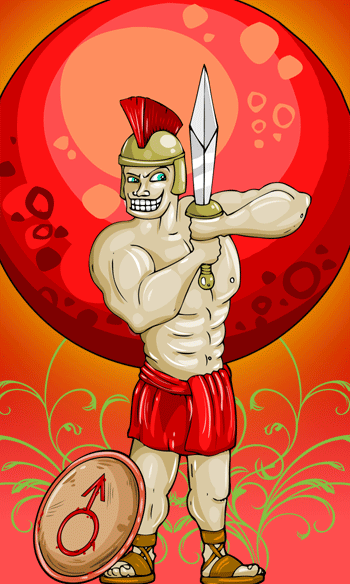Mars
Mars is the third of the classic planets. It is not one of the brightest, but it stands out for two reasons: It has a vivid orange-red colour and it makes large retrograde motions in the sky every year and a half. As we watch Mars from night to night, it slowly moves to the East. Every now and then (whenever Earth overtakes Mars in its orbit), Mars stops moving and reverses direction. After about a month, it resumes its normal eastwards motion.
As unique as this celestial course is, though, it was the colour that led the Romans to identify it with their version of the Greek god Ares.
Mars had an earthy, basic character. In the early days, he was primarily the god of agriculture, growth in nature, protection of cattle and similar things. As time passed though, he became associated with war, anger and revenge. Mars was Venus‘s favourite lover and she bore him two sons and a daughter. The sons, Phobos and Deimos, represented panic and fear, and worked hard during mortal battles (to the benefit of Mars’s favoured side). His daughter, Harmonia, had a completely different character. She was the goddess of harmony and accord (probably in rebellion against her father.) The names Phobos and Deimos have been immortalised as the two moons orbiting the planet Mars.
Two of Mars’ other children were Romulus and Remus, the legendary founders of Rome. For this reason, Mars was the single most worshipped god in all of Rome. He is honoured in the name of a month (March), and a day of the week (Tuesday, which comes from for an earlier version of Mars’ name).

The planet Mars doesn’t seem to match its Olympian namesake at all, though. It is small, light, cold and dry. Mars is about half the diameter of Earth and has only a tenth of its mass. This gives it a surface gravity that is about two fifths as strong as Earth’s. A day on Mars is about half an hour longer than on Earth. One Mars year is a little less than double that of an Earth year. Mars has an atmosphere, but it is only 1% as dense as Earth’s. For somebody on Earth to experience the same air pressure, they would have to climb to an altitude of around 30km – three times higher than a commercial air liner.
We probably know more about Mars than any other planet because of it’s relatively hospitable nature and close proximity. This makes it easy to study with science probes. For over a decade now, a growing number of wheeled robotic lander’s have been driving across Mars and studying the terrain, performing geology experiments. We have satellites in orbit equipped with high-resolution cameras, and many scientific instruments. They have returned some of the most spectacularly beautiful images of Martian dunes, dry riverbeds, canyons and mountains. Mars, being so close in environment to Earth, is also the most likely place to build our very first off-planet colony. In fact the technology exists to do this right now. It is such a pity that the financial priorities on earth do not yet extend beyond our atmosphere. As many have observed, the human race seems doomed to remain in the cradle for the foreseeable future.

